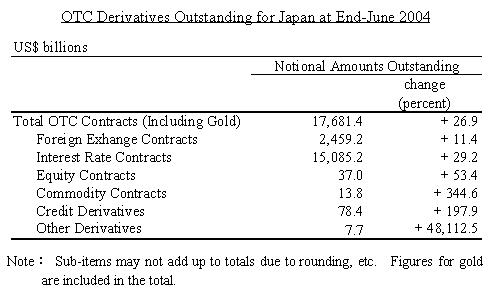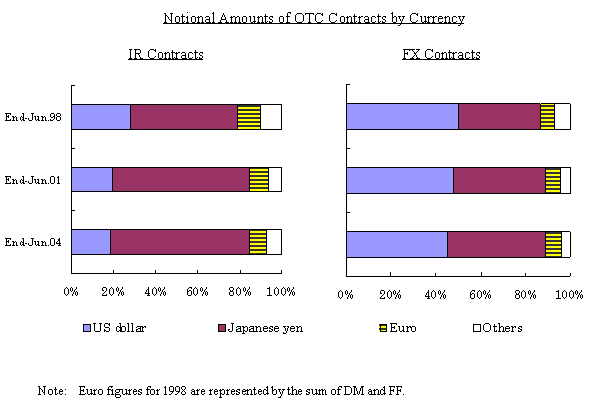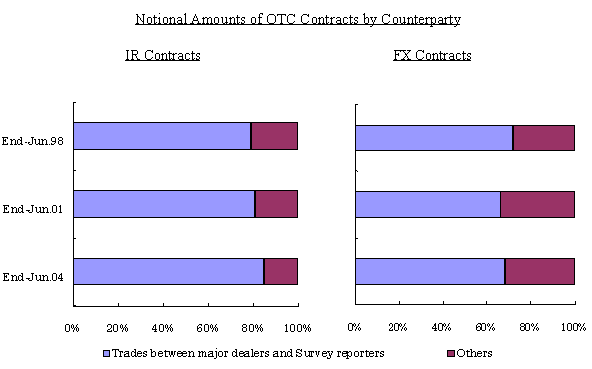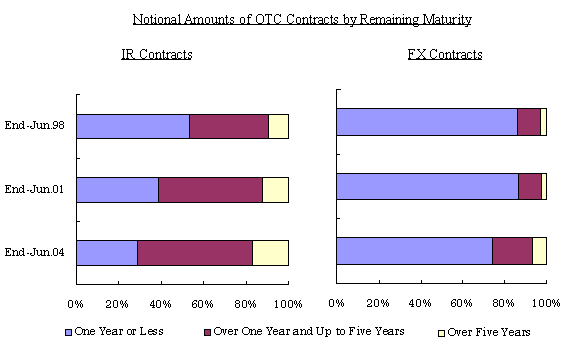Central Bank Survey of Foreign Exchange and Derivatives Market Activity at end-June 2004: Derivatives Amounts Outstanding, Japan
December 6, 2004
Bank of Japan
Financial Markets Department
- Click on deri0406.pdf (58KB) to download the full text.
The Bank of Japan is releasing today the results for Japan of the second part of the triennial Central Bank Survey of Foreign Exchange and Derivatives Market Activity, concerning the data on notional principal amounts outstanding at end-June 2004. This survey is a part of the triennial central bank survey, coordinated by the Bank for International Settlements (BIS).
Highlights of the survey results
1. Notional Amounts Outstanding: Overview
The notional amounts outstanding of derivatives transactions by Japanese institutions at end-June 2004 was at US$17.7 trillion for over-the-counter (OTC) contracts, increasing by +26.9 percent from the previous survey at end-June 2001. By risk factors, the amounts outstanding of foreign exchange-related contracts (FX contracts) was at US$2.5 trillion, increasing by +11.4 percent. That for interest rate contracts (IR contracts) was at US$15.1 trillion yen, increasing by +29.2 percent. Although the amounts outstanding are still relatively small, equity derivatives reached US$37.0 billion, commodity derivatives were at US$13.8 billion, and credit derivatives were at US$78.4 billion, increasing by +53.4 percent, +344.6 percent, and +197.9 percent, respectively.
2. Breakdown by Currency
In both the IR and FX markets, the US dollar and Japanese yen occupy a predominant role. In regard to IR related OTC derivatives, the US dollar and the Japanese yen kept their positions as the most popular currency with a market share of 84.6 percent, up somewhat from the 84.5 percent in the previous survey. Of this, the yen accounted for 66.0 percent, up from the 65.0 percent of three years ago. As for FX contracts, the US dollar and the Japanese yen held 88.9 percent of the total share, down from 89.1 percent in 2001. Of this, 43.7 percent was in Japanese yen, up from 41.3 percent at end-June 2001.
3. Breakdown by Counterparty
Inter-dealer transactions, defined as transactions between major dealers reporting for the Yoshikuni Statistics1 and financial institutions participating in the Survey, accounted for approximately 80 percent and 70 percent of notional amounts outstanding in IR and FX contracts, respectively.
1 Currently 13 major Japanese banks.
4. Breakdown by Remaining Maturity
IR contracts with remaining maturities of over one and up to five years increased from 48.7 percent in 2001 to 54.2 percent. For FX contracts, contracts with remaining maturities of one year or less continued to be dominant, accounting for 74.2 percent of total outstanding contracts, although having declined somewhat from 86.3 percent in 2001.
(attachment)
Outline of the OTC Derivatives Survey1
This Survey is a part of the triennial Central Bank Survey, coordinated by the BIS.2 The first part of the Survey on turnover covering data for April 2004 was released on September 29, 2004.
The second part of the Survey covers notional amounts outstanding on a consolidated basis3 at end-June 2004. The coverage, covering reporting financial institutions in 44 countries and regions, is more comprehensive than that for the semi-annual Regular Derivatives Market Statistics (Yoshikuni Statistics) which covers major dealers in G10 countries. In Japan, data from financial institutions with headquarters in Japan were collected from a total of 52 banks and 4 securities firms, including the 13 banks participating in the Yoshikuni Statistics.
The BIS, which coordinates and aggregates the global results of the Survey, is also publishing the preliminary results of the second part of the Survey and the global figures for the end-June 2004 Yoshikuni Statistics today (available on the BIS Internet Web site at http://www.bis.org/ (Link to an external website)). The results of the Yoshikuni Statistics at end-June 2004 for Japan were released on August 25, 2004.
The second part of the triennial survey and the Yoshikuni Statistics covers the notional amounts outstanding and gross positive/negative market values of foreign exchange, interest rate, equity, commodity, and credit derivatives. Breakdown by forwards, swaps, and options are also provided, as well as by currency and counterparty.4,5 Breakdown by maturity is also available for FX contracts, IR contracts, and equity derivatives.
- Data for previous survey results for Japan are available on the Bank of Japan's Internet Web site.
- Derivatives have been included since the end-March 1995 survey.
- Consolidated basis covers branches, subsidiaries, and affiliated companies both domestic and abroad.
- Classification of transactions for this survey is as follows. FX contracts and gold includes outright forwards and FX swaps, currency swaps, and currency options. IR contracts include FRA, IR swaps, and IR options. Equity, commodity, and other derivatives each include forwards and swaps as well as options. Credit derivatives includes forwards and swaps and options.
- Breakdown by currency is not available for commodity derivatives, credit derivatives, and other derivatives. Meanwhile, the latest credit derivatives data for Japan has been released as a part of the Yoshikuni Statistics results released on August 25, 2004. Data on credit derivatives are not yet collected on a regular basis globally, but data on credit default swaps are scheduled to be added in December 2004.




